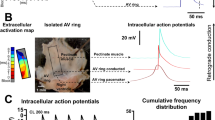Abstract
Spontaneous activity of specific regions (e.g., the Sinoatrial node, SAN) is essential for the normal activation sequence of the heart and also serve as a primary means of modulating cardiac rate by sympathetic tone and circulating catecholamines. The mechanisms of how a small SAN region can electrically drive a much larger atrium, or how a small ectopic focus can drive surrounding ventricular or atrial tissue are complex, and involve the membrane properties and electrical coupling within the SAN or focus region as well as the membrane properties, coupling conductance magnitudes and also regional distribution within the surrounding tissue. We review here studies over the past few decades in which mathematical models and experimental studies have been used to determine some of the design principles of successful propagation from a pacemaking focus. These principles can be briefly summarized as (1) central relative uncoupling to protect the spontaneously firing cells from too much electrotonic inhibition, (2) a transitional region in which the cell type and electrical coupling change from the central SAN region to the peripheral atrial region, and (3) a distributed anisotropy to facilitate focal activity.








Similar content being viewed by others
References
Auricchio A, Klein H (2000) Arrhythmias in heart failure. Curr Treat Options Cardiovasc Med 2(4):329–339
Beeler GW, Reuter H (1977) Reconstruction of the action potential of ventricular myocardial fibres. J Physiol 268:177–210
Benson DW, Wang DW, Dyment M, Knilans TK, Fish FA, Strieper MJ, Rhodes TH, George AL Jr (2003) Congenital sick sinus syndrome caused by recessive mutations in the cardiac sodium channel gene (SCN5A). J Clin Invest 112(7):1019–1028
Cai D, Winslow RL, Noble D (1994) Effects of gap junction conductance on dynamics of sinoatrial node cells: two-cell and large-scale network models. IEEE Trans Biomed Eng 41(3):217–231
Coppen SR, Kodama I, Boyett MR, Dobrzynski H, Takagishi Y, Honjo H, Yeh HI, Severs NJ (1999) Connexion45, a major connexion of the rabbit sinoatrial node, is co-expressed with connexion43 in a restricted zone at the nodal-crista terminalis border. J Histochem Cytochem 47(7):907–918
Courtemanche M, Ramirez RJ, Nattel S (1998) Ionic mechanisms underlying human atrial action potential properties: insights from a mathematical model. Am J Physiol 275(1 Pt 2):H301–H321
Dobrzynski H, Li J, Tellez J, Greener ID, Nikolski VP, Wright SE, Parson SH, Jones SA, Lancaster MK, Yamamoto M, Honjo H, Takagishi Y, Kodama I, Efimov IR, Billeter R, Boyett MR (2005) Computer three-dimensional reconstruction of the sinoatrial node. Circulation 111(7):846–854
Efimov IR, Nikolski VP, Rothenberg F, Greener ID, Li J, Dobrzynski H, Boyett M (2004) Structure-function relationship in the AV junction. Anat Rec A Discov Mol Cell Evol Biol 280(2):952–965
Golod DA, Kumar R, Joyner RW (1998) Determinants of action potential initiation in isolated rabbit atrial and ventricular myocytes. Am J Physiol 274:H1902–H1913
Irisawa H, Noma A (1982) Pacemaker mechanisms of rabbit sinoatrial node cells. In: Bouman HN, Jongsma HJ (eds) Cardiac rate and rhythm. Martinus Nihhoff Publishers, The Hague, pp 35–52
Janse MJ, Opthof T, Kleber AG (1998) Animal models of cardiac arrhythmias. (review) (163 refs). Cardiovasc Res 39(1):165–177
Joyner RW, Kumar R, Golod DA, Wilders R, Jongsma HJ, Verheijck EE, Bouman L, Goolsby WN, van Ginneken AC (1998) Electrical interactions between a rabbit atrial cell and a nodal cell model. Am J Physiol 274(6 Pt 2):H2152–H2162
Joyner RW, Picone J, Veenstra R, Rawling D (1983) Propagation through electrically coupled cells. Effects of regional changes in membrane properties. Circ Res 53(4):526–534
Joyner RW, van Capelle FJL (1986) Propagation through electrically coupled cells: how a small SA node drives a large atrium? Biophys J 50:1157–1164
Joyner RW, Wang YG, Wilders R, Golod DA, Wagner MB, Kumar R, Goolsby WN (2000) A spontaneously active focus drives a model atrial sheet more easily than a model ventricular sheet. Am J Physiol Heart Circ Physiol 279(2):H752–H763
Kodama I, Boyett MR (1985) Regional differences in the electrical activity of the rabbit sinus node. Pflugers Arch 404:214–226
Luo CH, Rudy Y (1994) A dynamic model of the cardiac ventricular action potential. I. Simulations of ionic currents and concentration changes. Circ Res 74:1071–1096
Masson-Pevet MA, Bleeker WK, Besselsen E, Mackaay AJC, Jongsma HJ, Bouman LN (1982) On the ultrastructural identification of pacemaker cell types. In: Bouman LN, Jongsma HJ (eds) Cardiac rate and rhythym. Martinus Nijhoff, The Hague, pp19–34
Veenstra RD, DeHaan RL (1986) Electrotonic interactions between aggregates of chick embryo cardiac pacemaker cells. Am J Physiol 250:H453–H463
Verheijck EE, Wilders R, Joyner RW, Golod DA, Kumar R, Jongsma HJ, Bouman LN, van Ginneken AC (1998) Pacemaker synchronization of electrically coupled rabbit sinoatrial node cells. J Gen Physiol 111:95–112
Wang YG, Kumar R, Wagner MB, Wilders R, Golod DA, Goolsby WN, Joyner RW (2000) Electrical interactions between a real ventricular cell and an anisotropic two-dimensional sheet of model cells. Am J Physiol Heart Circ Physiol 278(2):H452–H460
Wilders R, Jongsma HJ (1993) Beating irregularity of single pacemaker cells isolated from the rabbit sinoatrial node. Biophys J 65:2601–2613
Wilders R, Jongsma HJ, van Ginneken AC (1991) Pacemaker activity of the rabbit sinoatrial node. A comparison of mathematical models. Biophys J 60:1202–1216
Wilders R, Kumar R, Joyner RW, Jongsma HJ, Verheijck EE, Golod D, van Ginneken AC, Goolsby WN (1996) Action potential conduction between a ventricular cell model and an isolated ventricular cell. Biophys J 70(1):281–295
Wilders R, Wagner MB, Golod DA, Kumar R, Wang YG, Goolsby WN, Joyner RW, Jongsma HJ (2000) Effects of anisotropy on the development of cardiac arrhythmias associated with focal activity. Pflugers Arch 441(2–3):301–312
Author information
Authors and Affiliations
Corresponding author
Rights and permissions
About this article
Cite this article
Joyner, R.W., Wilders, R. & Wagner, M.B. Propagation of pacemaker activity. Med Bio Eng Comput 45, 177–187 (2007). https://doi.org/10.1007/s11517-006-0102-9
Received:
Accepted:
Published:
Issue Date:
DOI: https://doi.org/10.1007/s11517-006-0102-9




